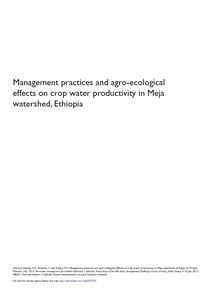Resource information
Mixed crop–livestock farming system is a major livelihood strategy in most sub-Sahara African countries. Low water use efficiency and water scarcity characterize the dominant rainfed agricultural production system in the densely populated highlands of Ethiopia. Improving water productivity in the rainfed system is among the ways of overcoming the water scarcity challenge. This study was conducted in Meja watershed, located in Jeldu district, West Shewa in the Ethiopian part of the Blue Nile Basin to estimate economic crop water productivity based on agro-ecology and crop management practices. The watershed was classified into three landscape positions (local agro-ecologies) and major crops representing at least 70% of each landscape position were identified through discussion with farmers and development agents. Five farmers field were randomly selected for each major crop and crop management practices implemented by the farmers were monitored and yield (grain or tuber and straw) was measured at harvest. The local market value of the crops and the production cost was estimated based on the local market value for labour and other inputs. CROPWAT model was used to estimate effective precipitation based on weather data generated using NewLocClim and crop characteristics. The result indicated that the landscape positions, crop variety and management practices significantly influenced the net economic water productivity. The net economic crop water productivity for barley, wheat, tef, sorghum and maize grains and fresh potato tubers were 3.31, 2.45, 3.09, 3.01 and 5.20 and ETB 13.56 m-3, respectively. Similarly, physical water productivity of the crops ranged from 0.47 for teff to 9.98 kg m-3 for fresh potato tubers. Hence, farmers can enhance economic benefit from the land and water resources they are endowed with rainfed by using improved agronomic practices that could raise grain/tuber and biomass yield. Enhancing improved input use, improving access to market for outputs and integrating livestock with crops may further augment the benefit at system scale.



